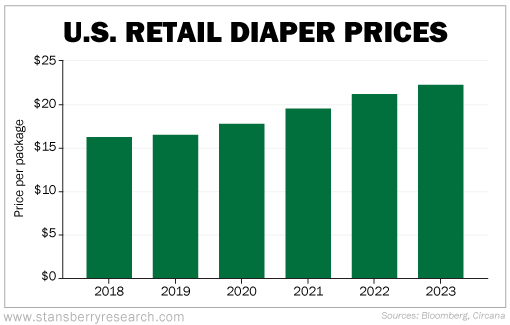Editor’s note: We’d like to introduce you to one of our industry’s brightest minds today…
We’re talking about our friend Dr. David Eifrig.
At our corporate affiliate Stansberry Research, he’s better known as “Doc.” And he has one of the most impressive resumes in the financial-newsletter business…
Doc got his MBA from Northwestern’s Kellogg School. Then, he spent a decade working for prestigious Wall Street firms like Goldman Sachs and Chase Manhattan.
After that, Doc shifted gears. He left Wall Street and earned his MD from the University of North Carolina. From there, he became a medical doctor and a board-eligible eye surgeon.
Doc made an even bigger move in 2008…
He joined Stansberry Research. And since then, he has leveraged his real-world experience to help folks improve their health, manage their money, and enjoy a prosperous retirement.
Put simply, Doc has seen it all.
Today’s essay first appeared in Doc’s free Health & Wealth Bulletin e-letter on February 28. Millions of Americans are dealing with this problem. And it’s likely worse than you realize…
Viridiana Montero is desperate for diapers…
The San Diego resident is a mother of three and works full time in a kitchen. Half her income goes to rent. Add in utilities, car payments, and food – and there’s not much left to cover her daughter’s heinie.
Montero uses more than $100 worth of diapers every month.
That’s money she often doesn’t have.
So when she learned that the Logan Temple AME Zion Church gives out free diapers, she became a regular at the church’s weekly Saturday giveaways.
Countless families are in the same situation as Montero.
It boils down to a diaper crisis in America…
Doing simple math, babies use up to 10 diapers a day. That adds up to 300 a month. The average cost of a diaper is roughly $0.30. So monthly diaper bills can top $100…
And that’s per kid.
If that sounds a lot higher than you remember, you’re not wrong.
Diaper inflation is real.
According to the research firm NIQ, the average package of disposable diapers cost $16.54 as recently as 2019. Now, the average price is around $21.90. That’s a 32% increase.
Here’s a chart from Bloomberg showing the price jump…
Understandably, this shift is putting pressure on millions of Americans.
The National Diaper Bank Network is a nonprofit that helps groups collect and give out free diapers to folks in need. It found that 47% of U.S. families struggled to afford diapers in 2023.
A few parents will attempt to potty train their children early to cut diaper costs. Montero told Harvard Public Health magazine that she would consider trying that.
Others may risk diaper rash, infections, disrupted sleep, and soiled clothes by stretching the life of a dirty diaper. Or they might experiment with the inconvenience of cloth diapers.
But for most American families, new disposable diapers aren’t optional. They’re a necessity.
Folks might have to stand in line at a church for a donation, go into credit-card debt, or dial back their other purchases. But when diapers get dirty, they change them. And when their supply runs out, they have no choice but to get more.
Ending this diaper crisis won’t be easy.
Roughly 225 diaper banks across the country try to help needy families. And other charities sometimes pitch in. But that’s often not enough.
In the coming months, efforts on both sides of the political aisle will ramp up for this year’s presidential election.
Of course, we’ll hear all the typical “politician speak.” The candidates will mostly dance around important issues that everyday Americans need to endure – like the diaper crisis.
But even the best politicians can’t avoid the real issues for long…
Americans want solutions, not long-winded rants.
Folks are starting to feel the pain because of higher prices. Families can’t even afford diapers for their newborn babies, for goodness’ sake.
Stocks are around all-time highs today. But things don’t feel all that great. Many families are carrying a credit-card balance much higher than in previous years.
We’ll see if this election can bring some change to help the typical American family.
But we don’t put too much faith in that.
Good investing,
Dr. David Eifrig
Editor’s note: Don’t fall for the “national distraction” in the coming months…
By that, regular readers know Chaikin Analytics founder Marc Chaikin is referring to the media’s election coverage – such as the polling data and who’s in the lead on any given day. As he says, it will come directly at the expense of your wallet in 2024… if you let it.
That’s why Marc recently put together a special presentation…
It’s the first time he has stepped forward this year. And importantly, he’s urging folks not to get blindsided by what he sees coming. Get the full story from Marc right here.
